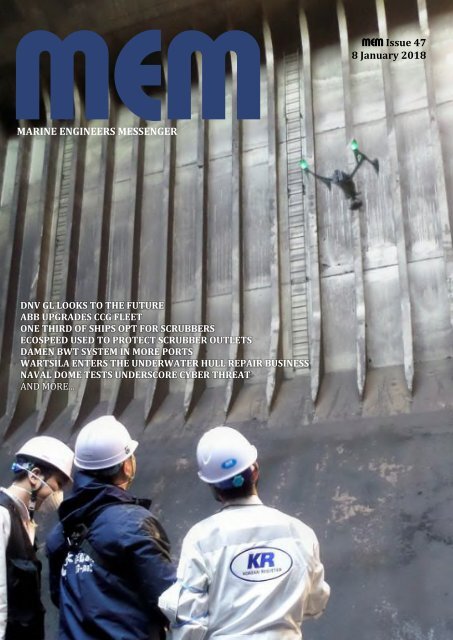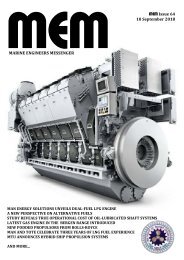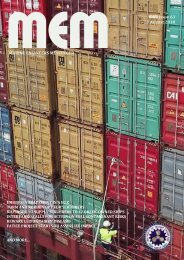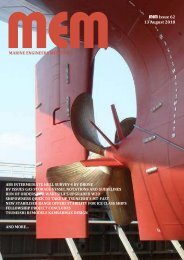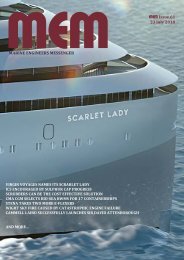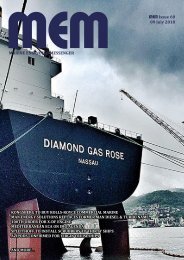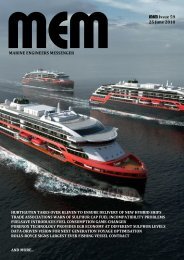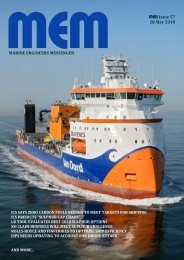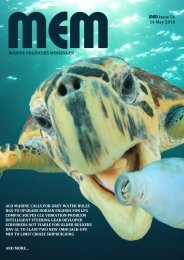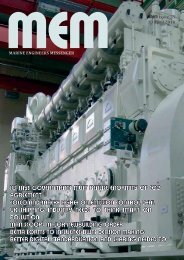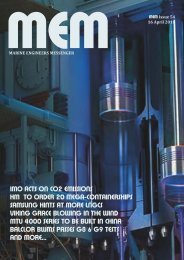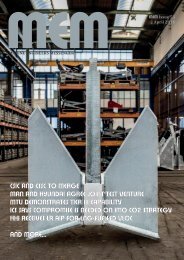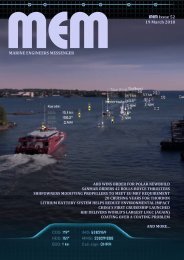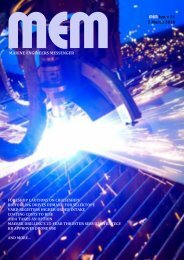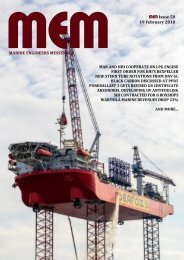MEM47
Marine Engineers Messenger, Volume 3, Issue 47
Marine Engineers Messenger, Volume 3, Issue 47
You also want an ePaper? Increase the reach of your titles
YUMPU automatically turns print PDFs into web optimized ePapers that Google loves.
MEM<br />
MEM<br />
MARINE ENGINEERS MESSENGER<br />
Issue 47<br />
8 January 2018<br />
DNV GL LOOKS TO THE FUTURE<br />
ABB UPGRADES CCG FLEET<br />
ONE THIRD OF SHIPS OPT FOR SCRUBBERS<br />
ECOSPEED USED TO PROTECT SCRUBBER OUTLETS<br />
DAMEN BWT SYSTEM IN MORE PORTS<br />
WARTSILA ENTERS THE UNDERWATER HULL REPAIR BUSINESS<br />
NAVAL DOME TESTS UNDERSCORE CYBER THREAT<br />
AND MORE...
MEM<br />
MARINE ENGINEERS MESSENGER<br />
MEM Issue 47<br />
8 January 2018<br />
Telegraph<br />
O<br />
pinion differs as to the shipping industry’s fortunes for 2018, with shipping adviser Moore Stephens<br />
pointing to “encouraging signs of recovery, and potential for further improvement”, while the ratings<br />
agency Fitch says the outlook for global shipping remains negative and does not “expect a material<br />
improvement in market fundamentals due to lingering overcapacity”.<br />
Looking further ahead, however, is DNV GL. According to the classification society’s Energy Transition<br />
Outlook (Martime), published in late December, shipping will continue to enjoy robust growth. But from<br />
2030 to 2050, demand will increase less rapidly , with growth primarily in non-energy commodities, such<br />
as the container trade and non-coal bulk.<br />
In addition to changing energy production and export patterns, shipping’s fuel mix will become much<br />
more diverse. While DNV GL expects oil to remain the main fuel option for trading vessels upto 2050,<br />
natural gas (LNG and LPG) will step up to become the second-most widely used fuel, and new low carbon<br />
alternatives will proliferate.<br />
“Big and rapid changes are happening in the way the world uses and produces energy,” says Remi<br />
Eriksen, Group President and CEO of DNV GL. “[The report ] shows that by mid-century, the energy supply<br />
mix is likely to split equally between fossil and renewables. Advances in energy efficiency will also see the<br />
world’s demand for energy flattening after 2030. These trends will impact all players in the maritime<br />
sector.”<br />
The classification society sees “the trends of today become the paradigms of tomorrow” as shipping<br />
continues its drive for greater efficiency by reducing costs, improving utilisation, lowering fuel<br />
consumption, increasing vessel size, and deploying new technologies.<br />
The 82 page report states that the move towards decarbonisation will challenge the way ships are<br />
designed and operated, while furture fleet-growth could be challenged by future regulations, requiring<br />
significant investment to ensure compliance.<br />
Changes in manufacturing processes will also have an impact. Additive manufacturing (3D printing),<br />
robotisation, and automation, for example, could engender the relocation of production back to developed<br />
countries, thereby shortening global value chains and potentially reducing demand for seaborne transport.<br />
DNV GL predicts that digitalisation, in particular, is expected to change current business models and how<br />
ships are operated, which may impact on their energy use.<br />
In the report’s Executive Summary, DNV GL states that phasing in autonomous ships will open the way<br />
for very low ship speeds without incurring high crew costs, and greater use of batteries and alternative<br />
fuels. The results are reduced energy demand, fuel use, and emissions. However, based on its forecast of<br />
the most likely future energy , the world will fail to achieve the Paris Agreement’s target of limiting<br />
average global warming to well below 2°C above pre-industrial levels.<br />
“Securing a 2°C future will not be achieved without a steeper reduction in the use, and hence transport,<br />
of fossil fuels,” the report states. “But this low-carbon future would require more energy-efficient ship<br />
designs and operations, and carbon-neutral fuels which, together with antipated regulations, might imply<br />
significant investment to upgrade and renew ships.”<br />
To help companies prepare for and mitigate carbon-related risk, the report includes a chapter on DNV<br />
GL’s “carbon-robust ship” concept, describing a three-step approach for evaluating and improving the<br />
carbon robustness of vessels and fleets.<br />
3
POWER<br />
HYBRID MODULES FOR ESCORT TUG<br />
Wärtsilä will supply two HY 2 hybrid power modules for a new escort tug being built for the Swedish port of<br />
Luleå located on the Gulf of Bothnia in the northern end of the Baltic Sea. The vessel is being built at Gondan<br />
Shipbuilders, in Asturias,<br />
Spain. When launched in<br />
early 2019, it will become<br />
the first vessel operating<br />
with a Wärtsilä HY solution.<br />
The Wärtsilä HY solution<br />
will bring notable<br />
environmental benefits, as<br />
well as operational and<br />
flexibility advantages that<br />
result in considerable<br />
economic gains. It will can<br />
operate on electrical battery<br />
power when in transit.<br />
Although it is configured as<br />
a mechanical set-up, the<br />
'hybrid diesel-electric'<br />
mode will allow the number<br />
of prime movers utilised to be reduced to just one for various operational tasks. These include ship assist with<br />
a bollard pull of up to 55 tons, or 90 tons on two main engines in diesel-mechanical mode. A bollard pull of 100<br />
tons will be available when in boost mode.<br />
The vessel will be capable of being completely independent from additional charging facilities, since recharging<br />
of the energy storage system will be automatically managed by the Energy Management System, the<br />
"brain" of the Wärtsilä HY. In addition, the installed onshore electrical connection will give the tug the<br />
flexibility to re-charge the energy storage system, even when the tug is berthed at the quay. The Wärtsilä HY<br />
product's operational flexibility will yield significant fuel, emissions, and maintenance cost savings.<br />
"We expect to see the Wärtsilä HY 2 hybrid power module becoming the new technological benchmark for<br />
tug propulsion systems given its clear economic, operational, and environmental benefits. The Wärtsilä HY<br />
technology opens the door to a new era in shipping, and is based on our unmatched in-house capabilities in a<br />
broad range of disciplines," explains Giulio Tirelli, Director, Marine Engineering, Wärtsilä Marine Solutions.<br />
"The integrated hybrid functionality of this vessel will give us a bollard pull of up to 100 tons, while saving<br />
fuel and maintenance costs and producing emission levels some 20% less than from a conventional ship of this<br />
type and size. In other words, we shall have first-class performance in both its operation and its environmental<br />
impact. We are very pleased to be getting a tug that reflects the future needs of the industry," says Henrik<br />
Vuorinen, Managing Director, Port of Luleå.<br />
"This new vessel will represent the state-of-the-art for modern tugs. The highly advanced technology<br />
enhances the overall performance in terms of operations, economics, and environmental impact," says Daniel<br />
Scavuzzo, Gondan Shipbuilders Commercial Manager.<br />
Since the Gulf of Bothnia is typically frozen over in winter, the 36m long tug will be capable of icebreaking<br />
operations and able to handle one metre thick ice at a speed of up to 3 knots. The Wärtsilä HY is designed to<br />
cope with these harsh conditions.<br />
The Wärtsilä HY scope includes an energy management system that optimises the combined use of the<br />
engines, the energy storage systems, and the power distribution train. The mechanical machinery part is based<br />
on two Wärtsilä 26 engines. The Wärtsilä scope also includes the tug's integrated automation and alarm<br />
system. The equipment is scheduled to be delivered to the yard during summer 2018.<br />
BATTERY SYSTEM FOR SUBSEA VESSEL<br />
Wärtsilä has agreed to retrofit the world’s first energy storage solution on board a large offshore supply vessel.<br />
The North Sea Giant, one of the world’s largest and most advanced subsea construction vessels, will be fitted<br />
with an energy storage system that reduces the vessel’s energy consumption, operating costs and exhaust<br />
emissions.<br />
The retrofit energy storage system improves the operational efficiency and environmental footprint of the<br />
North Sea Giant, responding to key requirements of Norwegian North Sea Shipping AS, the owner of the vessel.<br />
The solution provides power redundancy and increases responsiveness of vessel operations.<br />
4
Typically, a vessel with dynamic positioning uses two or more engines simultaneously to secure back-up<br />
power. This means that the engines’ load run low. By using a hybrid/battery system to provide the needed<br />
back-up power, the operational engine can be used closer to its optimal load. In addition to the hybrid/battery<br />
solution, the agreement includes transformers, filters, switchboard, shore connection equipment, upgrades of<br />
existing components and commissioning.<br />
“For us is it important to reduce environmental emissions and modernise the vessel to make it more<br />
competitive. In addition, with a more efficient vessel, we will save fuel expenses. The estimated reduction in<br />
emissions is 5.5 million kg CO2, 30 tons of NOx and 1,200 kg SOx per year. After Wärtsilä had retrofitted our<br />
ship Atlantic Guardian in 2014, we really understood how much fuel can be saved by improving the vessel’s<br />
efficiency. Efficiency also saves time, because you only need to refuel every second or third port visit,” says CEO<br />
Hallvard Klepsvik, North Sea Shipping AS.<br />
The North Sea Giant is a DP3 vessel. The ship is listed in the most advanced category of vessels that apply<br />
dynamic positioning. Installation of an energy storage solution into a class DP3 vessel has never been carried<br />
out before and requires a redefinition of applicable classification rules. Therefore, Wärtsilä and North Sea<br />
Shipping AS are working in close collaboration with the DNV-GL classification society.<br />
North Sea Shipping AS owns, operates and provides management services for advanced offshore supply<br />
vessels. Based in Austevoll on the west coast of Norway, the company has extensive experience in offshore<br />
shipping.<br />
“Wärtsilä has gained a high competence on hybrid projects on many different vessel types, and has a close<br />
relationship with the customers. For this reason, we can test new technology on many different types of vessels.<br />
We are the first in the world to work with hybrid systems on bigger vessels such as the DP3 classified North Sea<br />
Giant, and the project will set a new standard for this type of vessels,” says Cato Esperø, Director Sales Norway,<br />
Wärtsilä.<br />
ABB UPGRADES CCG FLEET<br />
ABB has successfully concluded the first<br />
modernisation on a Canadian Coast Guard (CCG)<br />
icebreaker, installing the latest hardware and<br />
software onboard the 38-year-old CCGS Pierre<br />
Radisson as part of the complete upgrade to the<br />
ship’s propulsion power distribution system that<br />
entailed the installation of twelve new DC-Drives<br />
and complete Propulsion Control System.<br />
The contract includes the option to amend the<br />
modernisations of two other ships in the CCG<br />
fleet, CCGS Des Groseilliers and CCGS Amundsen, both<br />
of which have clocked up more than 30 years of<br />
service.<br />
Ultimately the project also kicked off a fleet life<br />
extension program that will see ABB upgrading 10<br />
5
of the CCG’s 13 High Endurance Multi-Tasked Vessels as<br />
well as Heavy and Medium Icebreakers, which conduct<br />
major search and rescue operations and play a vital role<br />
in keeping the shipping lanes of northern Canada ice<br />
free.<br />
The upgrades will take place in succession between<br />
now and 2020 while the vessels are afloat and docked at<br />
their homeports, in partnership with a domestic<br />
specialist in electrical systems integration.<br />
Nathalie Pilon, President ABB in Canada, said: “We<br />
are delighted the Government of Canada selected ABB<br />
to support the Canadian Coast Guard in a project of this<br />
magnitude and importance for the nation’s maritime<br />
infrastructure and we look forward to building upon<br />
and continuing a longstanding cooperative relationship<br />
that will safeguard the fleet for many years to come.<br />
Investment in the icebreaking segment has grown in<br />
recent times. Reflecting its long history of working with<br />
icebreakers, ABB stands at the forefront of this regeneration.”<br />
Modernisation of CCGS Pierre Radisson was needed because the original power system, installed 38 years<br />
ago, was approaching end of life. While the upgrade will see the vessel retain its existing control arrangement<br />
of six AC alternators with rectifiers to supply direct current to the motors through upgraded breakers and<br />
contactors, the installation of the new ABB Drives will improve availability and extend endurance, allowing the<br />
ship to spend more time at sea.<br />
Specifically, ABB fitted twin AC/DC Diesel-Electric propulsion systems for greater redundancy, with each<br />
featuring a DC electric motor connected directly to the vessel’s propeller. ABB also took the opportunity to<br />
attach digital sensors to a variety of onboard equipment to provide its shore-based expert engineers with a<br />
virtual presence on board the ship to help diagnose problems at any time. ABB’s Remote Diagnostic Service<br />
will significantly improve maintainability and contribute to reduced vessel down time.<br />
Juha Koskela, Managing Director of ABB’s Marine and Ports business unit, said: “When CCGS Pierre<br />
Radisson was constructed in the late 1970s, ship to shore connectivity was mostly limited to radio. The<br />
Internet as we know it today simply did not exist. Today ships are digitally tethered to shore by satellite, which<br />
enables greater shore-side involvement and flexibility in vessel operations. The pivot to digital promises<br />
innumerable opportunities for the CCG’s icebreakers to operate safely and perform their missions more<br />
effectively.<br />
“We are proud to be working closely with the Canadian Coast Guard to help them maintain safe and reliable<br />
vessel operations for years to come. CCG vessels operate in harsh environments carrying out a variety of<br />
important missions year-round. By delivering improved vessel endurance together with round-the-clock<br />
Remote Diagnostic Service, we can support them in fulfilling those duties.”<br />
ELECTRICAL SYSTEMS<br />
BAKKER SLIEDRECHT SCOPE FOR NEW SIGMA 10514 LONG-RANGE PATROL VESSEL<br />
Bakker Sliedrecht has received the order from Damen Schelde Naval Shipbuilding (Damen) to deliver the<br />
electrical auxiliary propulsion system for a SIGMA 10514 long-range patrol vessel.<br />
Key components of the electrical auxiliary propulsion<br />
system are two 1325 kW electric propulsion motors<br />
from Indar and two water-cooled variable-frequency<br />
drives with active front ends. Both frequency drives will<br />
be cooled by one water-cool unit to save weight, space<br />
and costs.<br />
Each frequency drive will be connected to the vessel’s<br />
power grid, without the use of a transformer, to save<br />
weight and space. Without certain measures, this direct<br />
(conductive) coupling can cause unwanted effects on<br />
sensitive operational equipment connected to the grid.<br />
Bakker Sliedrecht created smart filter techniques to<br />
mitigate the disturbance levels in order to comply with<br />
the IEC- and Navy regulations. A selective earth fault<br />
detection is also included in this design. This<br />
6
evolutionary design has already been installed successfully by Bakker Sliedrecht on frigates for the Indonesian<br />
Navy.<br />
The new order is a result of the successful cooperation between Damen and Bakker Sliedrecht during the<br />
build of the guided missile frigates for the Indonesian navy. The long-range patrol vessel is scheduled for<br />
delivery in early 2020.<br />
PROPULSION<br />
RESEARCH VESSEL MODERNISED WITH SCHOTTEL PUMP JET<br />
The 28-year-old Aranda, the first Finnish vessel to be modernised with a<br />
diesel-electric hybrid propulsion system, will be fitted out with a<br />
Schottel Pump Jet.<br />
While the conventional shafting is being retained, an electrically<br />
powered Schottel Pump Jet (SPJ) of type SPJ 132 RD will be installed as<br />
a new auxiliary propulsion unit. It features an input power of 400 kW, is<br />
installed flush with the bottom of the research vessel and provides<br />
maximum thrust over the full 360° range, with no resistance, even in<br />
shallow water.<br />
After a very short project planning phase, the customer requested<br />
delivery of the equipment in three monthly partial shipments of well,<br />
steering system and propulsion unit. As the last item, the Pump Jet has<br />
now been shipped to the Finnish shipyard Rauma Marine Constructions.<br />
The Aranda is owned by the Finnish Environmental Institute and is<br />
intended for year-round research and surveying missions. Besides the<br />
propulsion assistance provided by the auxiliary drive, the SPJ is also<br />
used for dynamic positioning with an accuracy of half a meter.<br />
The resilient mounting means that the steel and cast-iron structure<br />
of the Pump Jet is completely isolated from the vessel’s hull, thus<br />
eliminating high-frequency excitations. In addition to extremely quiet<br />
operation, this property is a prerequisite for undisturbed seismic measurements, which will be one of the many<br />
tasks of the research vessel.<br />
The 59.2 m long and 13.8 m wide ice-going research vessel will also be fitted with a 3MW shaft generator.<br />
EMISSIONS<br />
ONE THIRD OF SHIPS TO CHOOSE SCRUBBERS<br />
According to naval architecture and engineering consultancy Foreship, shipowners weighing up their future<br />
marine fuel choices after the 2020 IMO 0.5% sulphur cap should also consider oil company expectations that up<br />
to 30% of commercial shipping will gravitate back to high sulphur fuel oil by 2030.<br />
With just over 100 ships running on LNG today, the number in service is likely to be significantly below 500<br />
by 2020. At the same time, while the 0.1% fuel sulphur content limit inside emissions control areas has brought<br />
1,500 scrubber installations, yard capacity could only<br />
grow that number to 3,000-4,000 by 2020. Most ships<br />
will run on 0.5% sulphur content HFO to meet the cap.<br />
Foreship Head of Machinery Department, Olli<br />
Somerkallio explains that, post 2020, 0.5% sulphur<br />
content fuel will be blended from distillates and HFO of<br />
up to 2.5% sulphur content. Higher sulphur HFO<br />
(HSHFO) can be used as a marine fuel where scrubbers<br />
are installed, but could also be a substitute fuel in gas<br />
powerplants in former Soviet countries, or a coal<br />
substitute. This will change the pricing dynamic of<br />
HSHFO: to compete with coal, prices would have to be<br />
relatively low.<br />
The implication is that HSHFO will return to favour as<br />
a marine fuel after the dust settles. “This will have a<br />
significant impact on the ROI of scrubbers in the future,”<br />
says Somerkallio.<br />
Foreship has significant experience in offering<br />
independent advice on adapting ships for new marine<br />
fuels and emissions abatement. Its reference list includes<br />
7
34 exhaust gas scrubber retrofit projects to enable 13 cruise ships, 11ro-pax ferries, nine ro-ros and one<br />
containership to burn HFO in ECAs. In this case, work includes conceptual design, technology and supplier<br />
evaluation, installation feasibility, the classification and basic design work needed for system integration, plus<br />
mechanical, piping, electrical systems and automation. Foreship also covers engineering and structural design<br />
for equipment foundations and new tanks, as well as safety plans and stability updates, supervising detail<br />
design and installation during systems integration.<br />
Foreship has advised customers to select multi-stream or in-line scrubbers, open loop, closed loop or hybrid<br />
systems. The high opportunity cost of losing sailing time in the cruise market has seen work planned<br />
underway, as well as for ro-ro ship projects work carried out in dock.<br />
“We have faced and overcome a broad range of installation challenges, including the fact that scrubbers eat<br />
into the revenue-earning space required for passengers or freight,” says Somerkallio. “We are also very<br />
familiar with the equipment options in the market and supplier references.” As well as needing new pumping,<br />
water treatment and tank storage equipment, exhaust gas scrubbers demand considerable new pipework on<br />
board. Installing inline means that existing silencers need to be replaced with larger equipment, causing a<br />
space challenge for casing.<br />
“Gaining this experience provides a wealth of independent experience that owners of cargo ships can draw<br />
on as the 2020 global sulphur cap approaches,” says Somerkallio. “The track record is also long enough to<br />
understand that ships within the same project do not always benefit from the same equipment selection.”<br />
AUXILIARY BOILERS<br />
JHT DELIVERS 200TH MHI-MME BOILER<br />
Jiujiang Haitian Equipment Manufacture (JHT), a licensee of Mitsubishi Heavy Industries Marine Machinery &<br />
Equipment has delivered its 200th MHI-MME Marine Auxiliary Boiler<br />
JHT, the state-owned marine equipment manufacturer owned by the China State Shipbuilding Corporation<br />
(CSSC) mainly received orders from shipyards under the CSSC umbrella. Other shipyards outside the CSSC<br />
group, however, have also placed orders. Their delivery record includes boilers not only for Chinese<br />
newbuildings but also vessels for European shipowners.<br />
The license agreement covers Auxiliary boiler which evaporation amount is up to 55 ton per hour, Exhaust<br />
Gas Economizer, Exhaust Gas Boiler, etc., and MHI-MME proceeds with further development and expansion of<br />
product line-ups to meet the market demand.<br />
MHI-MME, in the wake of the achievement of the 200 units order record, will accelerate business development<br />
in Chinese market further.<br />
LUBRICATION<br />
BLENDING-ON-BOARD SYSTEM LAUNCHED TO GREEK AND CYPRIOT MARKETS<br />
Piraeus-based Technava have commenced with the promotion of the<br />
Maersk Fluid Technology’s (MFT) SEA-Mate Blending-on-Board (BOB)<br />
system as the official sales agent for the technology in Greece and<br />
Cyprus.<br />
Originally developed by Maersk for use on A.P Moller-Maersk Group's<br />
fleet of containerships, MFT’s BOB technology allows for the blending of<br />
the in-use system oil, as a base oil, with a high-BN cylinder oil product to<br />
produce a Fit-for-Purpose cylinder lubricant and facilitate the addition of<br />
fresh system oil to the engine sump. With BOB units on board, ship<br />
operators can blend cylinder lubricant compositions that match actual<br />
engine operating conditions and fuel sulphur levels. The use of this<br />
technology can reduce cylinder oil consumption and alleviate issues such as<br />
cold corrosion and excessive cylinder wear. It can also mitigate issues<br />
associated with worn system oil causing problems for the hydraulic control<br />
system in modern, electronic two-stroke engines.<br />
The SEA-Mate BOB system has obtained letters of no objection from MAN<br />
Diesel & Turbo and Winterthur Gas & Diesel (WinGD) engines and is suitable<br />
for use on all types of two-stroke engines.<br />
Founded in 1968, Technava is a supplier of marine equipment and<br />
provider of technical support to the Greek and Cyprus shipping industry.<br />
Today, Technava is one of the leading companies in the supply, installation<br />
and service of equipment on board all types of ships. The company also acts<br />
as the representative for leading developer of two-stroke low-speed gas<br />
and diesel engines WinGD in Greece and Cyprus. The fact that WinGD is<br />
8
also working cooperatively with MFT, makes the establishment of Technava as the official sales agent for the<br />
SEA-Mate BOB system in Greece and Cyprus well positioned.<br />
“Maersk Fluid Technology is honoured to be working with Technava for the sales of our SEA-Mate BOB<br />
system in Greece and Cyprus. Our Blending-on-Board technology can support Greek and Cypriot ship owners<br />
with both changing engine operating conditions and fuel sulphur levels. Therefore, we believe that introducing<br />
our Blending-on-Board technology jointly with Technava, will bring great technical and financial value to the<br />
Greek and Cypriot marine industry,” says Jens Byrgesen, Managing Director at Maersk Fluid Technology.<br />
Andreas Angelidis, Projects' Engineer at Technava comments: “As a highly reputed supplier of marine<br />
equipment we welcome the opportunity to act as the sales agent for MFT in Greece and Cyprus. We represent<br />
first class manufacturers with strong brand names and highly reliable product, so we are proud to welcome the<br />
MFT SEA-Mate BOB system into our portfolio of products.”<br />
LNG CONTAINMENT<br />
GTT TO DESIGN THE LNG TANKS FOR NEW CARRIER<br />
GTT received at the end of 2017 an order from a South Korean shipyard regarding the design of the LNG tanks<br />
of a new LNG carrier scheduled for the first quarter of 2020.<br />
GTT will design the LNG tanks of the unit, allowing for a capacity of 174,000m3. The insulation solution<br />
Mark III Flex has been chosen for its ability to reduce the daily guaranteed Boil-Off gas rate to 0.085% of tank<br />
volume. 48 vessels in service already benefit from this technology.<br />
The shipowner and shipyard's names have not been disclosed at this stage.<br />
BALLAST<br />
BALLAST WATER TREATMENT IN EIGHT EUROPEAN PORTS<br />
Shipowners are now able to treat<br />
their unmanaged ballast water<br />
or load cleaned ballast water in<br />
eight different Northern<br />
European ports using Damen’s<br />
unique IMO certified InvaSave<br />
ballast water management<br />
system. In a cooperation<br />
between Damen Green Solutions<br />
and Damen Shiprepair &<br />
Conversion (DSC), this ballast<br />
water reception/bunkering<br />
service will be available in<br />
Rotterdam, Amsterdam, Brest,<br />
Dunkerque, Vlissingen, Den<br />
Helder, Stellendam and<br />
Harlingen.<br />
Damen’s InvaSave is the first<br />
external ballast water treatment<br />
unit designed primarily to offer<br />
shipowners a port-based ballast water solution. With this cooperation, vessels coming into these eight ports<br />
will be able to take advantage of a one-stop-shop for their ballast water treatment requirements.<br />
“Our goal is to build up a reliable worldwide ballast water service network,” says Philip Rabe from Damen<br />
Green Solutions. “Since the IMO Ballast Water Management Convention was enforced on 8th September 2017,<br />
some owners are already facing delays in ports due to unmanaged ballast water. For example, unmanned<br />
barges do not have the capabilities to perform mandatory ballast water exchanges; the D1 Standard.<br />
“With our ballast water bunkering service we can both accept used ballast water for disposal, as well as fill<br />
up ballast water tanks with certified clean water at the port of departure. As a result, this eliminates the need<br />
for ballast water exchange.”<br />
This service will offer benefits to many more clients, Rabe continues: “Vessels that use an on-board<br />
treatment systems and saltwater to make free chlorine will not always be able to function in freshwater ports<br />
such as Amsterdam. These vessels would need to load hundreds of tonnes of seawater to operate their onboard<br />
systems – and as a consequence, will lose precious cargo capacity.<br />
“Using the InvaSave ballast water treatment service in the port, vessels can load clean, D2 standard, ballast<br />
water at the quay without the need to operate their own on-board treatment systems.”<br />
Damen Green Solutions is in talks with several other ports and harbour service providers around the world<br />
to offer the InvaSave service.<br />
9
DECK EQUIPMENT<br />
RAPID TURNROUND FOR AHC ORDER<br />
Scantrol recently mobilized an Active Heave Compensation<br />
(AHC) Upgrade system in less than 4 hours for<br />
Aberdeenshire based solutions provider Aleron Subsea.<br />
“We were able to ship off a complete AHC system in only<br />
3 hours and 26 minutes due to a highly standardized<br />
control system and good communication with the<br />
customer. The system was already configured before<br />
shipment. In today’s subsea market we need to be able to<br />
turn around quickly when a customer needs an AHC system<br />
to get the job done. Upgrading an existing system is a costefficient<br />
and time-saving solution when working on a tight<br />
time-line,” explains Rolf Krogh Hjelmeland, Business<br />
Development Manager for Scantrol AHC.<br />
Aleron Subsea was appointed by James Fisher Marine<br />
and Britannia’s Gold Ltd (BGL) to utilise the AUXROV<br />
system to assist a highly profiled Salvage operation<br />
targeting wrecks that sank during World Wars 1 and 2. This<br />
is the first of a series planned operations by BGL.<br />
Working with a tight timeline to mobilize the equipment<br />
Aleron Subsea contacted Scantrol.<br />
The order was received on Monday lunchtime. The<br />
Scantrol team quickly turned around to meet the tight<br />
timeline of one day delivery time. Martin Nybø, Service<br />
Engineer at Scantrol, and his colleague, Johannes<br />
Sletteskog, managed to get the system assembled and<br />
tested before the end of the day and shipped off to<br />
Aberdeen on the same night. When Martin arrived the test<br />
site Tuesday morning together with the control system, the<br />
winch had only just been rotated by means of a hydraulic<br />
lever. Scantrol took advice from their associate UK<br />
Company, Dynamic Integrating Ltd, who vetted the<br />
hydraulic system for AHC compatibility. This reassurance<br />
took no time at all and Scantol were able to give Aleron a<br />
quick and confident solution.<br />
“By Tuesday evening we had the whole control system<br />
up and running, and were able to control the winch from it.<br />
Wednesday at lunchtime the system was fully<br />
commissioned and we were running dynatests showing<br />
promising compensation levels. In less than two days we<br />
had successfully integrated the control system with the<br />
winch and had it ready for shipping. This was achieved due<br />
to our standardized AHC solutions for different applications<br />
and to a dedicated and efficient team of engineers working<br />
on this project,” explains Martin.<br />
SUBSEA EQUIPMENT<br />
KONGSBERG INTRODUCES ITS LATEST ECHO<br />
SOUNDER<br />
Kongsberg has released the EM 304, the third generation of<br />
its de facto industry standard 30 kHz Multibeam Echo<br />
Sounder System. The technology is used for high resolution<br />
seabed mapping from depths of 10m to beyond the<br />
continental rises – deeper than 8000m.<br />
Developed as a low noise echo sounder with state-ofthe-art<br />
electronics, the EM 304 delivers superior data that<br />
requires minimal post-processing.<br />
In addition to offering increased range and resolution<br />
performance, the EM 304 introduces a broad range of<br />
Type Approved<br />
to IMO MEPC<br />
227 (64)<br />
MARIPUR NF<br />
CLARIMAR MF<br />
ACO Marine's new MARIPUR NF and CLARIMAR MF advanced<br />
wastewater management systems are the merchant, naval and<br />
megayacht sectors most effective solutions for meeting<br />
stringent IMO MEPC 227(64)<br />
rules.<br />
Compact and economical<br />
with the lowest operating<br />
costs of any sewage<br />
treatment plant, CLARIMAR<br />
MF and MARIPUR NF are<br />
proven to reduce<br />
coliform bacteria, TSS,<br />
COD, nitrogen and<br />
phosphorous content to<br />
levels significantly below<br />
the mandated requirements.<br />
Mark Beavis - Managing Director<br />
Nádrazňi 72, CZ -15000 Praha 5,<br />
Czech Republic<br />
Tel: +420 724 011 775<br />
Email: mbeavis@acomarine.com<br />
Web: www.acomarine.com<br />
10
functionality and cutting-edge new features that serve as a significant upgrade to the current generation EM<br />
302 system.<br />
As part of a new technology platform designed for future challenges, the EM 304 is compatible with a new<br />
Kongsberg-developed datagram format, which supports several new features, such as extended backscatter<br />
calibration, with more features already in development. The new format is supported by Kognifai, Kongsberg’s<br />
open digital ecosystem which brings opportunities to transform survey operations through digitalisation.<br />
“The EM 304 provides state-of-the-art survey vessel operators with the highest performance, most accurate<br />
mapping capability. The system replaces the EM 302 which has been the de facto industry standard since it was<br />
launched in 2006,” says Helge Uhlen, Director Sales Subsea. “The unparalleled performance of the EM 302 has<br />
resulted in a record number of medium-to-deep water systems being delivered for operations around the<br />
world, so we are pleased to introduce the next generation of our leading technology, which offers even more<br />
functionality and higher performance.”<br />
Considering the extensive EM 302 global user-base, KONGSBERG has developed the EM 304 to utilise the<br />
same transducers as its current generation system. This simplifies upgrading from the EM 302 to the new EM<br />
304 platform. Installation is optimised thanks to a highly, modular and flexible system with compact<br />
electronics. The EM 304 also accommodates easier installation through the use of a sub-bottom profiler. The<br />
KONGSBERG SBP 300 can be fully integrated, by sharing the same receiver transducer as the EM 304.<br />
The EM 304 is a highly scalable mapping system that takes advantage of features and benefits achieved in<br />
the development of the EM 2040 family and the EM 712. It joins Kongsberg Maritime’s unmatched range of<br />
leading Multibeam Echo Sounder Systems, from very shallow water to full ocean depth, all with proven<br />
superior performance and reliability.<br />
For operations in artic waters, the system can be delivered with ice windows for protection of the<br />
transducers, enabling light ice-class vessels to heavy ice breakers operating in the toughest ice conditions to<br />
enjoy the benefits of our new solution. And like all Kongsberg EM multibeam echo sounders, the EM 304<br />
ensures the best operating environment to safeguard marine life inhabiting the survey area, through decreased<br />
emitted sound levels.<br />
SHIP MAINTENANCE<br />
WARTSILA ACQUIES TRIDENT<br />
Wärtsilä has strengthened its service offering by acquiring Trident BV, a Netherlands-based company<br />
specialising in underwater ship maintenance, inspection, and repair services. Through the acquisition Wärtsilä<br />
becomes the first global operator in the underwater services market. The acquisition is estimated to be closed<br />
in January 2018.<br />
Wärtsilä has a long history in providing underwater services through partners. With this acquisition, the<br />
company builds in-house competence, captures the full potential of services' product synergies, and<br />
strengthens its position in the market.<br />
As a result, the acquisition enables the integration of Trident's services with Eniram's analytics. Wärtsilä<br />
expands its 'vessel-as-a-service' value offering to achieve maximum fuel savings by optimising hull cleaning<br />
cycles. Eniram is a Wärtsilä company focusing on providing the maritime industry with energy management<br />
technology to reduce fuel consumption and emissions.<br />
The enterprise value of the transaction is €17.5 million and an additional €3.5 million earn-out, based on<br />
the business performance in the coming years. The turnover of Trident is approximately €9 million.<br />
11
Trident Group, established in 1993, is a<br />
leading innovative underwater service<br />
supplier specialising in repair, overhaul,<br />
and maintenance of propulsion systems,<br />
hull, and machinery. With fully equipped<br />
workshops and certified personnel in the<br />
Netherlands, Italy, and Canary Islands, the<br />
company serves customers around the<br />
globe.<br />
"This acquisition supports Wärtsilä's<br />
strategy on several fronts, starting from<br />
Wärtsilä's purpose to enable sustainable<br />
societies with smart technologies.<br />
Reduced fuel consumption, efficiency<br />
improvements, and higher utilisation<br />
rates are always on the top of the<br />
operators' agenda," says Tamara de<br />
Gruyter, Vice President, Area North<br />
Europe and Propulsion System Services,<br />
Wärtsilä Services. "At the same time,<br />
environmental issues are becoming an integral part of customers' business planning. Trident is a pioneer in the<br />
development of environmentally sound solutions, for example, hull cleaning," de Gruyter continues.<br />
"We are very excited to join Wärtsilä," says Managing Director Adrie Huijbregts, Trident BV. "We have<br />
identified several synergies between the companies, such as the ability to develop more specific products due to<br />
increased knowledge, and thus provide an even more enhanced offering to our customers," he continues.<br />
Trident and Wärtsilä have previously co-operated in research and development. One result of this cooperation<br />
has been the jointly developed Wärtsilä-Trident Thruster preservation bag.<br />
MONITORING<br />
ARANDA MARINE RESEARCH VESSEL UPGRADE<br />
Valmet will upgrade the Aranda marine research vessel's control and machinery monitoring system to meet<br />
current needs as part of a renovation project for the vessel.<br />
Valmet's delivery includes the upgrade of the Valmet DNA control and machinery monitoring system, training<br />
and commissioning. The system is used to control and monitor the vessel's machinery and monitor alarms.<br />
The order was placed by Telesilta Oy, a Finnish company responsible for integrating electrification and the<br />
machinery monitoring system with other systems on the vessel.<br />
"As renovation projects are often technically very challenging, we wanted to have a product that we know<br />
well for our system. Successful cooperation with Valmet and its earlier experience with the original system on<br />
the vessel were two main reasons in favor of choosing Valmet DNA," says Kari Laulajainen, Managing Director,<br />
Telesilta.<br />
"Upgrading the control and machinery monitoring system increases the reliability of this advanced vessel. One<br />
of Valmet DNA system advantages is its easy upgradability to the latest technology," says Heikki Tanner, Sales<br />
Manager, Automation, Valmet.<br />
Owned by the Finnish Environment Institute (SYKE), the 30-year-old Aranda is an ice-reinforced research<br />
vessel. She was planned and built for<br />
Baltic Sea research but is able to operate<br />
on all seas. During construction, Aranda<br />
was equipped with a Valmet Classic<br />
machinery monitoring system that was<br />
upgraded to the Valmet Damatic XD<br />
system in 2006.<br />
Vessel renovation began by Rauma<br />
Marine Constructions at its Rauma<br />
shipyard in late July 2017 and will be<br />
finished in the spring. As part of the<br />
renovation project, Aranda's length will be<br />
extended by seven meters to 66 meters,<br />
and research and laboratory facilities will<br />
also be built.<br />
12
COATINGS<br />
ECOSPEED CHOSEN FOR SCRUBBER OUTLETS<br />
Subsea Industries’ glass-flake, non-toxic hard coating Ecospeed has been chosen to protect the exhaust<br />
scrubber outlets of three newbuild container vessels building at a yard in Zhoushan, China.<br />
A durable coating was required, with the ability to withstand the very high exhaust gas temperatures and<br />
the chemical pollutants encountered in this application. Scrubbers are intended to filter out oxides of sulphur<br />
and harmful hydrocarbons, soot, particulates, heavy metals and ashes to prevent pollution of the atmosphere.<br />
Some scrubbers, such as those fitted to these vessels, can also reduce the amount of nitrogen oxides and carbon<br />
gases.<br />
However, according to Subsea Industries, some shipowners have experienced damaged pipework at the<br />
outlet end of the scrubber system due to the highly corrosive wash waters produced during the exhaust gas<br />
cleaning process.<br />
Manuel Hof, Production Executive of Subsea Industries, said: “There have been some instances where<br />
unprotected pipework has completely corroded after just three years of scrubber operation. Shipowners and<br />
shipbuilders looking to install exhaust gas scrubbers must not overlook protecting internal pipework with an<br />
effective coating.<br />
“Ecospeed is highly suitable as a protective coating for scrubber outlets and interior surfaces because it is<br />
highly resistant to chemicals and will last the lifetime of the ship. The nature of the process taking place inside<br />
the scrubber requires a coating with special qualities, which Ecospeed can deliver.<br />
“Its proven durability means that no recoating will be required, cutting down on out-of-service time and<br />
thus saving the owner money in the long run. It is also highly resistant against a wide range of chemical<br />
products, which is one of the main reasons why Ecospeed is being increasingly selected for this kind of<br />
application.”<br />
Ecospeed’s durability has been proven by the fact that classification society DNV GL awarded it the highest<br />
B1 classification following tests of its suitability as a ballast tank coating. B1 is the superior grade in a six-grade<br />
classification system.<br />
13
Independent research has shown Ecospeed to be 100% toxin-free, with no adverse environmental effects<br />
resulting from its use or application, unlike other coatings which can contain biocides, copper or tin<br />
compounds.<br />
Shipping is coming under increasingly tight environmental legislation. The need to reduce sulphur emissions<br />
requires ships to either use expensive low-sulphur fuel oils, or fit exhaust gas scrubbers to remove sulphur and<br />
other harmful compounds from the exhaust gases before they are vented to the atmosphere. Scrubbers allow<br />
ships to continue to use the lower-cost heavy fuel oils, even in tightly-regulated coastal areas, so they are<br />
increasingly being installed onboard vessels. To maintain the scrubbers at optimum efficiency, they need a<br />
durable, inert coating to prevent corrosion.<br />
“Ecospeed fits in seamlessly with the environmental idea behind these systems,” said Hof.<br />
Subsea Industries is based in Antwerp, Belgium, and was founded in 1983 to develop a range of hard marine<br />
coating systems suitable for ship hulls as well as demanding applications such as interiors. All products have<br />
the common goal of clean rivers, seas and oceans, protecting and preserving the marine environment for future<br />
generations.<br />
NEWBUILDS & DELIVERIES<br />
DAMEN AND CONCORDIA<br />
JOIN FORCES<br />
Damen Shipyards Group and<br />
Concordia Group have signed a joint<br />
venture agreement with the purpose<br />
of cooperating in the construction<br />
and trade of inland waterway<br />
vessels. The joint venture will<br />
operate under the name Concordia<br />
Damen Shipbuilding.<br />
“Damen and Concordia are<br />
joining forces in order to better<br />
support clients in their investments.<br />
Concordia Damen Shipbuilding will,<br />
beside catering to the general<br />
demand, focus on the development<br />
of sustainable vessels with a<br />
diversity of new shipbuilding<br />
techniques, in order to achieve a<br />
bright and clean future for shipowners.<br />
We are very pleased to<br />
partner with Damen to expand our<br />
activities in the inland waterways<br />
market. We look forward to working<br />
together with Damen and its<br />
international network of shipyards<br />
and sales,” says Chris Kornet, CEO of<br />
Concordia.<br />
Concordia has been active in the<br />
Dutch inland waterways business<br />
since 2001 and also internationally<br />
over the past 10 years. The<br />
corporate identity of Concordia will<br />
remain within the new joint venture.<br />
The joint venture will increase<br />
production capacity.<br />
This year, Damen is celebrating<br />
its 90th birthday. The company has<br />
been active in almost all sectors of<br />
the maritime industry since the<br />
beginning of the 20th century.<br />
Damen operates a global network of<br />
shipyards as well as an international<br />
SAVE MILLIONS IN DRYDOCK<br />
COSTS AND OFF-HIRE TIME<br />
Hull of cruise ship after 5 years with Ecospeed coating with no replacement or major repair. This is the state<br />
of the hull when the ship came out of the water, without any cleaning or touch-up in drydock.<br />
When your hull coating never needs<br />
replacing or major repair, you can<br />
save a lot of money in drydock fees, offhire<br />
time, materials and labour.<br />
Most hull topcoats are designed to be<br />
replaced once or twice every five years.<br />
The full hull coating scheme has to be<br />
fully replaced every 10 - 15 years down<br />
to bare steel.<br />
Over that time period, the coating<br />
degrades and becomes rougher until it’s<br />
no longer worth trying to patch it up.<br />
www.<br />
And it costs you a fortune in fuel to<br />
compensate for the additional hull<br />
friction.<br />
Imagine a coating that’s guaranteed for<br />
10 years and is expected to last 25<br />
without replacement or major repair. A<br />
coating that gets smoother over time, not<br />
rougher!<br />
Imagine coming into drydock after 3 or 5<br />
years and finding that your hull coating<br />
only requires a few minor touch-ups and<br />
doesn’t even need to be washed off.<br />
Call us today for a quote to convert your hull to Ecospeed or start off right, with<br />
Ecospeed, on a new build.<br />
EU Office<br />
Phone: + 32 3 213 5318<br />
Fax: + 32 3 213 5321<br />
info@ecospeed.be<br />
US Office<br />
Phone: + 1 727 443 3900<br />
Fax: + 1 727 443 3990<br />
info@ecospeed.us<br />
.be<br />
14
sales and service network. The Inland Waterways team, led by Product Director Inland Waterway Transport<br />
Simon Provoost, will move from the Damen headquarters in Gorinchem, to the Concordia office in Werkendam,<br />
the Netherlands.<br />
“Both parties are very pleased with this partnership and look forwards towards a future with ambition and<br />
mutual trust,” says Mr. Provoost, who will be appointed as Managing Director of Concordia Damen<br />
Shipbuilding.<br />
ICEBREAKING CRUISE VESSEL FOR PONANT<br />
Ponant has developed an innovative and environmentally friendly luxury cruise vessel in close cooperation<br />
with Aker Arctic and Stirling Design International.<br />
The Ponant Icebreaker intends to take passengers to never explored polar destinations, such as true<br />
geographic North Pole, the Weddell Sea, the Ross Sea and Peter I Island. To ensure operation in these harsh and<br />
ice infested areas, PONANT contracted Aker Arctic to take part in the design of the vessel. Prior to start of the<br />
development, the different operational areas were evaluated to set up the design basis for the operation and<br />
vessel technical requirements. Aker Arctic has utilized its long-term experience as an icebreaker designer in<br />
developing this world’s first luxury icebreaker cruise vessel with PC 2 ice class.<br />
“We are delighted to work with the world’s leading expedition operator PONANT and ship design company<br />
Stirling Design International. The combined expertise of the companies involved in the project has resulted in<br />
this pioneering cruise vessel for the polar regions” states CEO Reko-Antti Suojanen, Aker Arctic.<br />
Ponant has confirmed the order with the Norwegian shipyard VARD which has previously also built<br />
icebreaking vessels based on Aker Arctic design. “We are looking for a continued cooperation in the building<br />
phase of the project” states Reko-Antti Suojanen.<br />
SECURITY<br />
CYBER PENETRATION TESTS UNDERSCORE NIGHTMARE<br />
SECURITY SCENARIO<br />
Naval Dome has demonstrated the maritime industry’s nightmare security scenario<br />
with a series of cyber penetration tests on systems in common use aboard tankers,<br />
containerships, superyachts and cruiseships. Test results revealed with startling<br />
simplicity the ease with which hackers can access and over-ride ship critical<br />
systems.<br />
With the permission and under the supervision of system manufacturers and<br />
owners, Naval Dome’s cyber engineering team hacked into live, in-operation<br />
systems used to control a ships’ navigation, radar, engines, pumps and machinery.<br />
While the test ships and their systems were not in any danger, Naval Dome was<br />
able to shift the vessel’s reported position and mislead the radar display. Another<br />
15
attack resulted in machinery being disabled, signals to fuel and ballast pumps being over-ridden and steering<br />
gear controls manipulated.<br />
Commenting on the first wave of penetration tests, on the ship’s Electronic Chart Display and Information<br />
System (ECDIS), Asaf Shefi, Naval Dome's CTO, the former Head of the Israeli Naval C4I and Cyber Defense Unit,<br />
said: "We succeed in penetrating the system simply by sending an email to the Captain's computer.<br />
“We designed the attack to alter the vessel’s position at a critical point during an intended voyage - during<br />
night-time passage through a narrow canal. During the attack, the system's display looked normal, but it was<br />
deceiving the Officer of the Watch. The actual situation was completely different to the one on screen. If the<br />
vessel had been operational, it would have almost certainly run aground.”<br />
According to Shefi, the Naval Dome hack was able to alter draught/water depth details in line with the<br />
spurious position data displayed on screen.<br />
“The vessel's crucial parameters - position, heading, depth and speed - were manipulated in a way that the<br />
navigation picture made sense and did not arouse suspicion,” he said. "This type of attack can easily penetrate<br />
the antivirus and firewalls typically used in the maritime sector.”<br />
Commenting on the ease with which Naval Dome was able to by-pass existing cyber security measures, Shefi<br />
explained: "The Captain's computer is regularly connected to the internet through a satellite link, which is used<br />
for chart updates and for general logistic updates. Our attacking file was transferred to the ECDIS in the first<br />
chart update. The penetration route was not too complicated: the attacking file identified the Disk-On-Key use<br />
for update and installed itself. So once the officer had updated the ECDIS, our attack file immediately installed<br />
itself on to the system.”<br />
In a second attack, the test ship’s radar was hit. While the radar is widely considered an impregnable,<br />
standalone system, Naval Dome's team used the local Ethernet Switch Interface - which connects the radar to<br />
the ECDIS, Bridge Alert System and Voyage Data Recorder – to hack the system.<br />
“The impact of this controlled attack was quite frightening,” said Shefi. "We succeeded in eliminating radar<br />
targets, simply deleting them from the screen. At the same time, the system display showed that the radar was<br />
working perfectly, including detection thresholds, which were presented on the radar as perfectly normal.”<br />
A third controlled attack was performed on the Machinery Control System (MCS). In this case, Naval Dome's<br />
team chose to penetrate the system using an infected USB stick placed in an inlet/socket.<br />
"Once we connected to the vessel's MCS, the virus file ran itself and started to change the functionality of<br />
auxiliary systems. The first target was the ballast system and the effects were startling. The display was<br />
presented as perfectly normal, while the valves and pumps were disrupted and stopped working. We could<br />
have misled all the auxiliary systems controlled by the MCS, including air-conditioning, generators, fuel systems<br />
and more.”<br />
Itai Sela, CEO of Israel-headquartered Naval Dome, furthered that the virus infecting ship systems can also<br />
be unwittingly transferred by the system manufacturer.<br />
“As manufacturers themselves can be targeted, when they take control of onboard computers to carry out<br />
diagnostics or perform software upgrades, they can inadvertently open the gate to a cyber attack and infect<br />
other PC-based systems onboard the ship. Our solution can prevent this from happening.”<br />
16
PEN TEST PARTNERS ESPOUSE SHODAN’S CYBER SECURITY GAME CHANGER<br />
Following their recent blog which highlighted vessel satcom box vulnerabilities using Shodan, a search engine<br />
which finds devices connected to the internet, Pen Test Partners has again warned ship owners and operators<br />
to ensure their satcom boxes are secure.<br />
In the updated blog, senior partner Ken Munro explains how he was able to use a new real time ship-mapping<br />
feature on Shodan to geo-locate vulnerable vessels through their satcom boxes.<br />
By combining this with AIS data, a hacker has everything they need to select a suitable ship to attack. They can<br />
choose a vessel en route to a nearby port, ready for load theft. Or perhaps cripple a ship in a particular area,<br />
ready for piracy.<br />
“Although it was possible before to find a specific vessel’s location, it required a lot of work to analyse and<br />
present it on a map. The new mapping feature makes it trivially easy for hackers and criminals alike,” said Mr<br />
Munro.<br />
He went on to urge ship owners and operators to secure their satcom boxes by changing default passwords and<br />
applying all updates received from their satellite communication providers immediately.<br />
AUTOMATION<br />
ROLLS-ROYCE AND MITSUI O.S.K. LINES TO DEVELOP SHIP INTELLIGENT AWARENESS<br />
Rolls-Royce has signed a deal with<br />
Japanese multi-modal transport<br />
company Mitsui O.S.K. Lines (MOL), to<br />
collaborate in the development of its<br />
intelligent awareness system.<br />
The collaboration will be on board<br />
165 metre passenger<br />
ferry SUNFLOWER, which is owned<br />
and operated by Mitsui O.S.K. Lines’<br />
subsidiary company.<br />
Ferry SUNFLOWER operates on a 222-<br />
nautical mile route between Kobe and<br />
Oita via the Akashi Kaikyo, Bisan Seto<br />
and Kurushima Straits.<br />
Rolls-Royce Intelligent awareness<br />
systems will make vessels safer, easier<br />
and more efficient to operate by<br />
providing crew with an enhanced understanding of their vessel’s surroundings. This will be achieved by fusing<br />
data from a range of sensors with information from existing ship systems; such as Automatic Identification<br />
System (AIS) and radar. Data from other sources, including global databases, will also have a role.<br />
Kenta Arai, Director at Mitsui O.S.K. Lines, said: “Ferry SUNFLOWER operates in some of the most congested<br />
waters in the world and will provide an opportunity to test rigorously Rolls-Royce’s intelligent awareness<br />
system. We also expect it to provide our crews with a more informed view of a vessel’s surroundings in an<br />
accessible and user-friendly way. This can give our crews an enhanced decision support tool, increasing their<br />
safety and that of our vessels. This is a significant challenge to front-line technology leading to our ultimate goal<br />
of autonomous sailing.”<br />
Asbjørn Skaro, Rolls-Royce, Director Digital & Systems – Marine, said: “We are exploring and testing how to<br />
combine sensor technologies effectively and affordably. Pilot projects such as this allow us to see how they can<br />
be best adapted to the needs of the customer and their crews so that our product effectively meets the needs of<br />
both.<br />
“Successful pilots and product development programmes are also an important step towards the further<br />
development of remote and autonomous vessels and meeting our goal of having a remote controlled ship in<br />
commercial use by the end of the decade.”<br />
Rolls-Royce expects to be able to undertake an Approval of Concept and have its intelligent awareness<br />
product commercially available in 2018.<br />
The system builds on experiences from R&D work worldwide. The intelligent awareness system will benefit<br />
from Rolls-Royce’s extensive experience in the Tekes funded project Advanced Autonomous Waterborne<br />
Applications Initiative (AAWA), which has been running since June 2015. The company has been conducting a<br />
series of tests of the sensor arrays in a range of operating and climatic conditions on board Finferries’ 65 metre<br />
double ended ferry Stella, which operates between Korpo and Houtskär in the Archipelago Sea on the southwest<br />
coast of Finland.<br />
17
NAVIGATION & ELECTRONICS<br />
SIMPLIFIED LICENSING FOR C-MAP<br />
C-MAP, the supplier of digital marine cartography and cloud-based mapping solutions, has announced the<br />
availability of 'FixedFee', a new, simplified licensing concept. C-MAP FixedFee enables customers to access all<br />
the Electronic Navigational Charts (ENC) they require, for an annual fixed amount.<br />
FixedFee provides complete access to global ENCs for voyage planning and navigation, combined with easy<br />
chart updating, one annual invoice and the ability to license whatever charts a customer might need for a 12-<br />
month period.<br />
“We want to give our customers freedom of choice,” said John Klippen, Head of Commercial Services, C-MAP.<br />
“Modern navigation is complex and our aim at C-MAP is to make things easier. FixedFee offers customers a<br />
simple and straightforward way to acquire and manage the charts they need for safe and efficient navigation.”<br />
Available for AVCS and C-MAP ADMIRALTY ENC Service (CAES) - FixedFee offers the same flexibility as C-<br />
MAP FlatFee service without being a PAYS based solution.<br />
CLASSIFICATION & REGULATION<br />
ABS TO CLASS LNG BARGE<br />
ABS has been selected by Q-LNG, LLC to class an Articulated Tug Barge (ATB) for LNG bunkering in North<br />
America. The vessel is scheduled to begin construction at VT Halter Marine in Pascagoula, Mississippi, in early<br />
2018.<br />
“This project represents another significant milestone for the region in the continued development of LNG<br />
infrastructure in North America, helping the maritime industry meet stricter emissions requirements,” says<br />
ABS Chairman, President and CEO, Christopher J. Wiernicki. “ABS is committed to working with all project<br />
stakeholders to support safety both during construction and operations.”<br />
“We chose ABS as our class partner for this project because of their extensive understanding of LNG as fuel<br />
and LNG bunkering applications,” says Q-LNG Transport President Chad Verret. “This project will expand the<br />
LNG supply chain and play a critical role in the advancement of LNG as a marine fuel throughout the region and<br />
North America.”<br />
The LNG bunker barge, with 4,000m3 LNG capacity, will be owned and constructed by Q-LNG while the<br />
operations will be handled by New Orleans-based Harvey Gulf International Marine. The barge will be<br />
chartered by Shell, and will supply necessary LNG fuel to cruise vessels throughout the Southeast Coast of the<br />
US. The barge will be designed to be efficient and manoeuvrable to allow LNG bunker delivery to a range of<br />
customers.<br />
ABS is also classing the LNG bunkering barge for North America that is currently being built at Conrad<br />
Orange Shipyard and is scheduled for delivery in 2018.<br />
18
RULES UPDATE FOR SHIP CONSTRUCTION<br />
Classification society ClassNK has announced that it released amendments to its Rules and Guidance for the<br />
Survey and Construction of Steel Ships on 25 December 2017.<br />
ClassNK is constantly revising its Rules and Guidance in order to reflect the latest results from relevant<br />
research and development projects, feedback from damage investigations, requests from industry as well as<br />
changes made to relevant international conventions, IACS unified requirements (UR), national regulations, etc.<br />
More specifically, some of the requirements amended this time are as follows:<br />
Amendment related to the Incorporation of Material Factors for High Tensile Steel into Structural Strength<br />
Requirements of Floating Docks (to incorporate research and development results)<br />
Amendment related to the Intermittent Power Demand of Motors for Steering Gear Power Units Marking of<br />
Safe Working Loads (in response to industry requests, etc.)<br />
Amendment related to the Fuel Consumption Reporting (in response to changes in international<br />
conventions, etc.)<br />
Amendment related to the Testing Procedures of Watertight Compartments (in response to changes in IACS<br />
Unified Requirements, etc.)<br />
The PDF files of ClassNK Rules and Guidance are available free of charge via ClassNK’s<br />
website www.classnk.com for those who have registered for the ClassNK “My Page” service. To register for<br />
the “My Page” service free of charge, go to ClassNK’s website and click on the “My Page Login” button.<br />
KR TO CARRY OUT SURVEYS USING DRONES<br />
The Korean Register (KR) is now<br />
conducting inspection services using drones,<br />
responding to the industry-wide trend to<br />
use more unmanned technology.<br />
The new service<br />
follows extensive collaboration and research<br />
conducted with the University of Gyeongnam<br />
Geochang.<br />
The drone inspection is expected to save<br />
KR’s customers time and money and enhance<br />
the safety of the classification society’s<br />
workforce. The Inspection is conducted<br />
onboard, in and around ships and many of<br />
the inspected areas are high risk and difficult<br />
to access safely. The inspections will be<br />
carried out using drones (U.A.V. unmanned<br />
aerial vehicle) and underwater drones<br />
(R.O.V. remotely operated vehicle) and will<br />
be an important part of the decision-making<br />
and assessment process for KR’s surveyors,<br />
complimenting their traditional surveying<br />
skills.<br />
After researching the possibilities and<br />
technology available, KR successfully<br />
completed a series of tests utilising cameraequipped<br />
drones for ship inspections, and at<br />
the same time established a registration<br />
process for service suppliers, including the University of Gyeongnam Geochang. The two organisations now<br />
plan to work together on future technological developments.<br />
Lee Jeong-kie, Chairman and CEO of KR said: “We are delighted to announce that we can now offer full ship<br />
inspection services with camera-equipped drones, employing the very latest technology. This development will<br />
be a significant advantage for our customers’, saving their time and capital resources as well as increasing<br />
efficiency and safety at the worksite, which I hope, will in turn improve competitiveness across the shipping<br />
industry.<br />
“This is just the latest development in KR’s continuous efforts to identify and develop new practical ways to<br />
meet our clients’ needs, and to enhance their businesses prosperity”.<br />
Moving forward, KR plans to provide services using a variety of different drones to expand its inspection<br />
service areas. To offer high quality and more diverse services to more clients, KR will carry out further research<br />
and development into the relevant technology, while vetting and registering more secure service suppliers<br />
around the world, particularly in China and across Asia.<br />
19
BUSINESS NEWS<br />
CONFIDENCE REMAINS AT HIGH LEVEL<br />
Shipping confidence held steady at its highest rating in the past three-and-a-half years<br />
in the three months to end-November 2017, according to the latest Shipping<br />
Confidence Survey from international accountant and shipping adviser Moore<br />
Stephens.<br />
The average confidence level expressed by respondents was unchanged at<br />
the level of 6.2 out of 10.0 recorded in the<br />
previous survey in August 2017. Confidence<br />
on the part of charterers was significantly up,<br />
from 4.7 to 7.7, the highest rating recorded<br />
for this category of respondent since the<br />
survey was launched in May 2008 with an<br />
overall rating of 6.8. Managers (up from 5.8<br />
to 6.1) were also more optimistic, while<br />
brokers’ confidence was unchanged at 6.3.<br />
The rating for owners, however, fell from 6.5<br />
to 6.4. Confidence levels were down in Asia,<br />
from 6.4 to 5.7, and unchanged in Europe and<br />
North America, at 6.3 and 5.8 respectively.<br />
The likelihood of respondents making a major investment or significant development over the next 12<br />
months was down from 5.4 to 5.3 out of 10.0. Charterers’ confidence, however, was up from 4.0 to 6.2.<br />
Expectations on the part of owners and brokers were up from 5.8 to 5.9 and from 4.4 to 5.3 respectively, but<br />
down from 5.4 to 5.3 for managers. Asian respondents (down from 5.9 to 5.0) were less confident in this<br />
regard, but in North America the rating was up from 4.9 to 5.4. In Europe, expectations held steady at 5.2.<br />
Although overall expectations of making major investments over the next 12 months were marginally down<br />
on the three-year high recorded in the previous survey, several respondents saw encouraging signs of recovery,<br />
and potential for further improvement, particularly in the dry bulk sector. One respondent said: “Undeniably,<br />
things are a little better, but there is not such a significant improvement that we can break out the champagne<br />
and celebrate a recovery.”<br />
59% of respondents expected finance costs to increase over the coming year, up from 50% last time to equal<br />
the highest figure since October 2008. Owners’ expectations were up from 48% to 54%, while the increase for<br />
charterers was from 67% to 83%, and for brokers from 42% to 60%. Managers, meanwhile, recorded a fall<br />
from 62% to 61%.<br />
Despite a fall from 27% to 23%, demand trends continued to be the factor expected to influence<br />
performance most significantly over the coming 12 months followed by competition and finance costs. One<br />
respondent said: “Shipping continues to be volatile and unstable, with an oversupply of tonnage, and new<br />
finance continuing to pour in, while geopolitical issues and new regulations are causing disruption.”<br />
The number of respondents expecting higher freight rates over the next 12 months in the tanker market was<br />
down by 1% on the previous survey to 44%, while there was a one percentage-point fall, to 13%, in those<br />
anticipating lower rates. There was a six percentage-point fall, to 50%, in the numbers expecting higher rates in<br />
the dry bulk sector, and a five percentage-point increase to 12% in the numbers anticipating lower rates. In the<br />
container ship sector, the numbers expecting higher rates dropped by four percentage points to 36%, while<br />
there was a two percentage-point fall, to 15%, in those anticipating lower container ship rates.<br />
Net sentiment was positive in all the main tonnage categories. It was unchanged in the tanker market at +31,<br />
but down in the dry bulk market from +49 to +38, and in<br />
the container ship sector from +23 to +21.<br />
Richard Greiner (pictured), Moore Stephens partner,<br />
Shipping & Transport, says, “Confidence is at its highest<br />
level for three-and-a-half years, testament to the industry’s<br />
remarkable durability. Not all our respondents were<br />
upbeat and uncertainty persists, for example, over how<br />
and when to comply with the Ballast Water Management<br />
Convention and the true extent of cyber-crime. A<br />
slowdown in newbuilding activity has started to redress<br />
the imbalance in supply and demand, and that should be<br />
reflected in improved freight rates. There is an appetite for<br />
investment, and finance is available.”<br />
20
RENK ACQUIRES DAMEN SCHELDE GEARS<br />
Marine gear manufacturer Renk has<br />
acquired a 100% stake in Damen<br />
Schelde Gears B.V.<br />
The December 2017 acquisition of<br />
the Netherlands-based company will<br />
see the company rebranded as Schelde<br />
Gears B.V. (SG).<br />
The new Dutch facility is able to<br />
draw on many years of experience in<br />
gear design, calculations as well as<br />
inspections and overhaul of marine<br />
gears.<br />
MACGREGOR ACQUIRES WINCH MANUFACTURER<br />
MacGregor, part of Cargotec, has signed an agreement to acquire Rapp Marine Group (RMG) in order to<br />
strengthen its offering for the fishery and research vessel segment. MacGregor's existing portfolio includes<br />
already various deck handling equipment, such as cranes and booms, but with RMG, MacGregor is able to offer<br />
complete solutions with advanced winches and related control systems. The enterprise value of the acquisition<br />
was approximately €16 million.<br />
"We are happy to join forces with MacGregor and be part of the company. The agreement will benefit the<br />
niche customer base, which will be now offered a wider portfolio of safe and efficient equipment from one<br />
provider to their specific vessels," says Terje Arnesen, CEO of RMG.<br />
"I am happy to see that Rapp Marine Group, under our five years of ownership, has developed to become a<br />
global leader in providing winches and related equipment to fishery and research vessels. Many of these<br />
projects have been developed and delivered in close cooperation with MacGregor Triplex, and as such I am<br />
convinced that the positive development in RMG will continue under Macgregor's new ownership," says Bjørn<br />
Hesthamar, managing partner in Nord Kapitalforvaltning, the PE-company now selling RMG.<br />
"MacGregor has a strategic interest in widening services for customers within fishery and research segment.<br />
Products needed for these demanding vessel types have to be safe, robust and reliable with a good after sales<br />
network," says Michel van Roozendaal, President, MacGregor. "This is exactly what our combined offering is<br />
able to provide, be it fishery segment that operates in harsh conditions, or solutions needed for research<br />
vessels to handle sophisticated tools and equipment".<br />
"With MacGregor's Triplex deck handling portfolio we already today have a very strong position in the<br />
fishery and research segment and with this investment as part of our growth strategy we are able to further<br />
strengthen our position," states Høye Høyesen, Vice President, Advance Offshore Solutions, MacGregor.<br />
The results of RMG business will be consolidated in MacGregor business area results once the transaction<br />
has been completed which is expected during the first quarter of 2018.<br />
RMG employs about 120 people with main locations in Norway, the USA and United Kingdom. The sales in<br />
2017 is estimated to be approximately €40 million, of which approximately 30% is related to service. RMG's<br />
profitability (EBIT-margin) is on the same level as MacGregor's current profitability.<br />
21
FEATURE ARTICLE<br />
LNG AS A MARINE FUEL: TIPPING POINTS, STEP CHANGES, BLIZZARDS, AND<br />
SNOWBALLS<br />
By Stephen Cadden, COO, and Steve Esau, General Manager of SEA\LNG<br />
As we begin a new year, this feels like a natural point for reflection on the year that’s passed, as well as some<br />
projections for the 12 months ahead. One theme that pervaded every month of 2017 for the marine<br />
industry was 2020 – the 0.5% global sulphur cap looms large and has been the source of much debate and<br />
conjecture. Although it could be argued that there remain more unanswered questions than definite answers,<br />
the momentum behind LNG as a viable, sustainable marine fuel is undeniable.<br />
Despite an uncertain jigsaw when it comes to the future fuel matrix, prices, and availability, ship owners are<br />
continuing to bet on LNG’s potential by ordering LNG-fuelled vessels. A survey conducted by German trade fair<br />
organiser, Hamburg Messe and Congress revealed that 44% of respondents cited LNG as their first choice when<br />
contemplating newbuild orders. And evidence shows that this is being acted upon.<br />
Today there are 119 LNG-powered vessels in operation with a further 1251 on order. The passenger and<br />
cruise segment can be commended for leading the charge and stimulating the demand for LNG bunkers. A<br />
headline from Interferry 2017 – “From Ferry-tale to Reality” – captures this sentiment well! This trend<br />
continues with Carnival’s seven newbuilds on order, plus newbuildings planned by Royal Caribbean and P&O<br />
Cruises, to give just a few examples.<br />
But importantly, this confidence in the future of LNG as a marine fuel is now permeating other segments of<br />
the industry too, to cite a few examples; Teekay Offshore Partners has options for two Suezmax-sized, DP2<br />
shuttle tankers, Van der Kamp has a dredger on order, and the OOS Zinlandia – the world’s largest semisubmersible<br />
crane vessel – will also be LNG-fuelled. In the US, TOTE Maritime (TOTE), Matson, and Pasha<br />
Hawaii, have all announced LNG-fuelled newbuilds. And TOTE announced its partnership with MAN Diesel &<br />
Turbo for its retrofit of Alaska trade vessels.<br />
However, what really marks a step change in the evolution of LNG as a marine fuel is that we are now seeing<br />
orders for deep sea shipping extending beyond ECAs, for example Sovcomflot has ordered six Aframax tankers,<br />
Siem has two transatlantic car carriers on order for charter to Volkswagen, Polaris Shipping confirmed orders<br />
for ten, LNG-ready very large ore carriers (VLOCs). Notably, 2017 culminated in a major announcement from<br />
CMA CGM, stating that it will power its nine ultra-large container ship newbuilds – due to be delivered from<br />
2020 – with LNG delivered by Total. “LNG is the fuel of the future for shipping,” Rodolphe Saade, chairman and<br />
chief executive of CMA CGM was quoted as saying.<br />
Like a game of chess, this decision by CMA CGM is so significant as it tips the balance for so many that may<br />
have – until now – been contemplating their next move, waiting to see how the largest industry actors will<br />
influence 2020 game plans. Other container lines are now likely to follow suit, as volume brings investment,<br />
which expands infrastructure and stimulates supply chains. The snowball effect is inevitable.<br />
The lack of infrastructure is always top of the list for those citing the largest hurdles to uptake of LNG as a<br />
marine fuel. However, this argument is being steadily eroded and it’s fair to say that 2017 represents a tipping<br />
22
point for LNG<br />
infrastructure. Indeed,<br />
one respected industry<br />
publication recently<br />
reported “a blizzard of<br />
LNG bunkering<br />
developments in 2017.”<br />
And it certainly seems<br />
that way – of the world’s<br />
top oil-bunkering ports,<br />
nine of the top ten (the<br />
exception being Long<br />
Beach) offer LNG<br />
bunkering or will do so by<br />
2020.<br />
LNG is now readily available in bulk at approximately 150 locations worldwide, and there is a huge bulk LNG<br />
infrastructure of regasification terminals and liquefaction plants globally. Of significance, this infrastructure is<br />
already well aligned with many deep-sea trade routes. It is the movement of LNG from bulk facilities to the<br />
ships, more commonly known as the ‘last mile’, where efforts are being concentrated to enable easy access to<br />
LNG as a marine fuel. Ship-to-ship (STS) transfers are a much quicker and more efficient operation than<br />
jettyside truck-to-ship (TTS) bunkerings, and by 2018 there will be six LNG bunker vessels in service globally,<br />
with four more projects confirmed.<br />
Gas4Sea has the Engie<br />
Zeebrugge, its Zeebruggebased<br />
5,000m3 LNG bunker<br />
vessel that was delivered in<br />
April 2017 and the first LNG<br />
bunker vessel to enter into<br />
operation. In August 2017,<br />
Shell took delivery of the<br />
6,500 m3 Cardissa, an LNG<br />
bunker tanker that is being<br />
operated from Rotterdam.<br />
Shell has also announced a<br />
cooperation with Anthony Veder on the<br />
conversion of the Dutch shipowner’s<br />
7,500m3 coastal LNG carrier Coral Methane into a bunker<br />
vessel, with plans for long-term charters of bunker barges serving the<br />
Amsterdam, Rotterdam, and Antwerp (ARA) region in North West Europe and the southeast coast of the<br />
US. Skangas took delivery of a purpose-built LNG bunker vessel this summer – the 5,800m3 Coralius. The Clean<br />
Jacksonville is North America’s first ocean-going LNG bunker barge, with a 2,200 m3 fuel capacity. And Titan<br />
LNG will introduce its first LNG bunker vessel, the FlexFueler1 pontoon, in mid-2018 to enable the delivery of<br />
LNG fuel to vessels throughout the ARA region.<br />
With the majority of LNG bunkering stations currently located in Europe, the region currently dominates the<br />
LNG bunkering market with a share of 85%. But with high marine trade and home to Singapore, the world’s<br />
largest bunkering location; Asia-<br />
Pacific is expected to catch up quickly.<br />
Ports play a crucial role in facilitating<br />
this uptick in confidence, not only in<br />
relation to infrastructure, but also<br />
through incentives. This year, for<br />
example, the Maritime and Port<br />
Authority of Singapore (MPA)<br />
commenced its LNG bunkering pilot<br />
project, which provides various<br />
companies grants of up to S$2 million<br />
per LNG-powered vessel constructed;<br />
and in Japan, the Yokohama-Kawasaki<br />
International Port has initiated an<br />
ambitious LNG bunkering programme.<br />
23
Looking ahead, the supply side is gearing<br />
up significantly and we are seeing<br />
announcements for investments in the next<br />
tier of bunker vessels, focused on NW<br />
Europe, the US East Coast, China, and Korea.<br />
ENN Group, for example, has announced<br />
plans to develop an LNG-bunkering hub at<br />
Zhoushan, near Shanghai, which includes<br />
plans for an 8,000m³ LNG bunker-supply<br />
ship. The Wärtsilä built Tornio Manga LNG<br />
terminal project in Northern Finland also has<br />
plans to provide bunkering for LNG fuelled<br />
ships visiting the northern Baltic Sea waters.<br />
And with increasing bulk LNG supply<br />
capacity from Qatar, the US, Australia, and<br />
Russia, new entrants and pressure from<br />
existing buyers for more flexible, shorterterm<br />
contracts are likely to stimulate the<br />
emergence of a more liquid LNG market.<br />
On the regulatory side, we are seeing a push to develop uniform bunkering standards, informed by the work<br />
our partner association, the Society for Gas as a Marine Fuel (SGMF), is doing. Striving for harmonisation of<br />
regulations on a global level is critical to the long-term success of LNG. Ports, for example, are learning from<br />
early adopters, such as the Ports of Rotterdam and Jacksonville, and sharing knowledge and best practice to<br />
create uniform local regulation.<br />
The global 0.5% Sulphur cap provides immediate impetus for the development of LNG as a marine fuel, but<br />
as new Emission Control Areas (ECAs), with far tighter local emissions limits, emerge, this stimulus will<br />
increase further. ECAs are being considered in areas including the Mediterranean, the Strait of Malacca, Central<br />
America, Japan, and Australia. And China is taking a phased approach to the introduction of full ECAs by<br />
regulating the Sulphur content of fuels at four locations around their major ports. The introduction of new ECAs<br />
supports local and regional uptake of LNG as a marine fuel, and longer term, bunkering infrastructure<br />
established in the ECAs is likely to emerge as key hubs for the deep-sea shipping space.<br />
We know that ship owners are looking for certainty on LNG supply and infrastructure, and those developing<br />
the infrastructure are looking for people to order LNG-fuelled ships. With so many examples of tipping points<br />
and step changes for LNG in terms of both newbuilding orders and infrastructure developments throughout<br />
2017, it seems that the blizzard of change will continue through 2018, with a snowball effect that’s gathering<br />
momentum apace towards 2020 and beyond.<br />
As an organisation, SEA\LNG has grown from 13 founding members to more than 30, representing the<br />
entire marine LNG value chain, uniting key players including shipping companies, classification societies, ports,<br />
major LNG suppliers, downstream companies, infrastructure providers, shipyards, and OEMs. We are proud<br />
that our members have been at the forefront of developments during 2017, which will no doubt continue<br />
through 2018 and the years ahead.<br />
MEM Marine Engineers Messenger<br />
Publisher: Seaborne Communications Ltd<br />
Contributions: Bill Thomson<br />
Email: mem@seabornecomms.com<br />
Web: www.seabornecomms.com<br />
The information published in MEM does not<br />
necessarily represent the views of Seaborne<br />
Communications Ltd. The publisher makes no<br />
representation or warranty as to the accuracy or<br />
correctness of the information or accepts<br />
responsibility for any loss, damage or other liability<br />
pertaining to the information published in this<br />
newsletter.<br />
©2018 Seaborne Communications Ltd<br />
24


